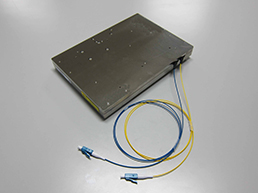Japan
Fujitsu introduces 100Gbps Coherent Transceiver
- High speed and high capacity transmission performance for use in backbone networks -
Kawasaki, Japan, September 19, 2011- Fujitsu Optical Components Limited (FOC) announced today that on April, 2012 it will be releasing a coherent transceiver for 100Gbps digital coherent transmission systems (*1) as defined in the OIF (*2) 100GLH-ME-01.0 specifications. This product will help to enable the development of optical network equipment with 100Gbps Ethernet transmission capabilities on backbone networks.

Rapid increase in the volume of communications traffic has come from the spread of new services such as mobile broadband using smart phones, cloud computing and on-line streaming. This has created a demand to put the research and development that has gone into 100Gbps optical networks into practical use.
The ITU-T (*3), which has been promoting the standardization of the OTN (Optical Transport Network) to transport 100G Ethernet signals over backbone networks, has created the OTU4 optical interface standard in Recommendation G.709. The OIF is also promoting international standardization for 100Gbps Long-Haul DWDM Transmission Modules.
Using the technologies described below, FOC has successfully commercialized a 100Gbps coherent transceiver as defined in the OIF 100GLH-ME-01.0 specifications for 100Gbps digital coherent transmission systems. This product will help enable the development of high-performance optical network equipment with the capability of transmitting 100G Ethernet signals (as defined in the OTU4 optical interface of ITU-T G.709) over backbone networks.
Key Technology
- Digital coherent signal processing technology
In high-speed transmission, the transmission distance is limited due to the waveform distortion that occurs in the optical transmission path. In conventional systems, dispersion compensators are applied to compensate for the waveform distortion. In this new application, digital signal processing has been applied to compensate the waveform distortion by electric signal processing. This has resulted in great improvement of the transmission performance and enabled cost reduction in the system through the elimination of optical dispersion compensators. The 100G Digital Coherent Signal Processing LSI (DSP-LSI) in the digital signal processor is made by NTT Electronics Corporation. The DSP-LSI incorporates the outcome of "R&D on High Speed Optical Transport System Technologies" supported by the Ministry of Internal Affairs and Communications of Japan. (*4) - Optimal control technology for optical devices used in digital coherent systems
FOC developed the technology that optimally controls the LN modulator and the integrated receiver (incorporating an internal optical hybrid mixer for DP-QPSK (*5) modulation/demodulation) used in this module. The module design has shown high stability when subjected to environmental change. FOC has already commercialized both the DP-QPSK LN modulators for optical transmission and the DP-QPSK Integrated Receiver used in this product. - Compact circuit design/high density mounting technology
Digital coherent technology generally requires about twice the circuit size of conventional systems. FOC has developed circuit design technology that reduced this circuit size considerably. When combined with FOC's high density mounting technology, a compact 100Gbps transceiver that is the same size as a standard 40 Gbps transceiver (127mm×177mm×17 mm) has been achieved.
Pricing & Availability
| Product Name | Pricing | Shipment |
|---|---|---|
| 100G Coherent Transceiver | Quoted per order | April, 2012 |
Additional Information
- http://www.fujitsu.com/jp/foc/en/
Glossary & Notes
(*1) Digital coherent transmission systems:
Uses DP-QPSK modulation and compensates the waveform distortion that occurs in the optical transmission path by digital signal processing in the optical receiving section. This technique allows for significant reduction in system cost through the elimination of optical dispersion compensators and optical amplifiers (for loss compensation).
(*2) OIF:
Acronym for Optical Internetworking Forum. The OIF is an organization that promotes standardization for the equipment and components used in optical networks
(*3) ITU-T
Acronym for International Telecommunication Union-Telecommunication sector. It is one of the three sectors (divisions or units) of the International Telecommunication Union (ITU) and coordinates standards for telecommunications.
(*4) DSP-LSI:
Second generation DSP-LSI utilizing built in high performance forward error correction with soft decision decoding to enable high performance transmission.
(*5) DP-QPSK:
Acronym for Dual-Polarization Quadrature Phase Shift Keying. It is a method of phase modulation for digital signals, in which 2 bits of data are allocated to each of 4 modulated optical phases (0, 90, 180, 270°) for both P-polarized and S-polarized light.
Customer Contacts
Fujitsu Optical Components Limited
Sales & Business Development Division
Marketing & Business Development Dept.
![]() E-mail: optmdl-pr@ml.css.fujitsu.com
E-mail: optmdl-pr@ml.css.fujitsu.com
About Fujitsu
Fujitsu is a leading provider of information and communication technology (ICT)-based business solutions for the global marketplace. With approximately 170,000 employees supporting customers in over 100 countries, Fujitsu combines a worldwide corps of systems and services experts with highly reliable computing and communications products and advanced microelectronics to deliver added value to customers. Headquartered in Tokyo, Fujitsu Limited (TSE:6702) reported consolidated revenues of 4.5 trillion yen (US$55 billion) for the fiscal year ended March 31, 2011. For more information, please see: www.fujitsu.com.
About Fujitsu Optical Components
Aiming to strengthen Fujitsu's optical module business, Fujitsu Optical Components was established on April 1st, 2009 as a wholly owned subsidiary of Fujitsu Limited. With the establishment of the new company, the sales, research and development, and manufacturing functions of Fujitsu's optical module business are integrated under a unified management structure. Headquartered in Kawasaki, Japan, Fujitsu Optical Components is a leading supplier of the most advanced, high-reliable and customer-focused optical components for datacom and telecommunications applications in the global market. Its broad products line-up includes DWDM pluggable transceivers, full-band tunable 300pin transponders, G-PON transceivers and 40G/100G components. For additional information, visit http://www.fujitsu.com/jp/foc/en/.
All other company or product names mentioned herein are trademarks or registered trademarks of their respective owners. Information provided in this press release is accurate at time of publication and is subject to change without advance notice.
- arrow-double-r02.gif (01 KB)
- cookie-allowance-bg.gif (02 KB)
- cookie-gig4.css (02 KB)
- cookie-gig4.js (03 KB)
- onload-css.js (00 KB)
日付: 15 September, 2011
About this Website
- Terms of Use
- Privacy
